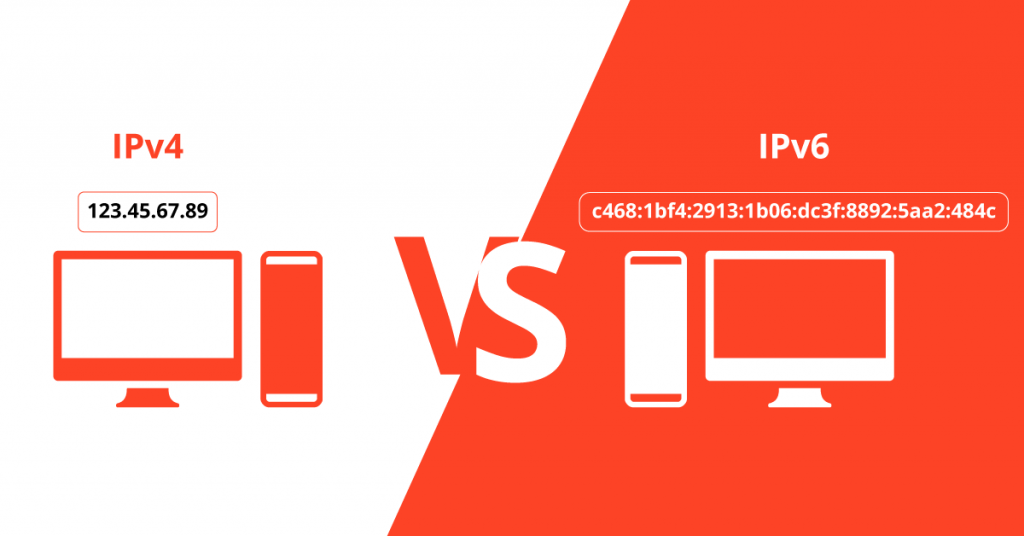Table of Contents
The transition from IPv4 to IPv6 marks a significant milestone. With the world facing the exhaustion of IPv4 addresses, IPv6 emerges as the beacon of hope, promising a virtually infinite address space. In this blog post, we will explore the differences between IPv4 and IPv6 and what IPv6 is used for.
What is IPv6?
IPv6, or Internet Protocol Version 6, is the most recent version of the Internet Protocol (IP), the set of rules that devices use to send and receive information over the Internet. It was created to replace IPv4, the former version because IPv4’s address space had run out.
IPv6 significantly increases the number of available IP addresses, making it possible for billions of new devices and users to connect to the Internet. Additionally, IPv6 enhances internet traffic’s efficiency, security, and performance.
IPv6 address example
An IPv6 address is a 128-bit binary number comprising eight groups of four hexadecimal digits separated by colons. It looks something like this:
41b8:82a7:9824:e936:1ee7:346c:8721:240b
This new format allows for about 340 undecillion unique IP addresses (that’s 340 trillion trillion trillion!). It is a huge increase from IPv4, which only has about 4.3 billion available addresses. IPv6, with its expanded address capacity, facilitates the development of the Internet of Things (IoT), linking everyday objects to the web.
Exhaustion of IPv4 Address Space
The exhaustion of the IPv4 address space has been a growing concern over the past few decades. This shortage arose due to the unforeseen explosive development of the internet and the proliferation of internet-connected devices.
Each device connecting to the Internet requires a unique IP address, and IPv4’s 32-bit addressing scheme was not designed to accommodate the sheer volume of devices and web services today. This limitation has necessitated developing and adopting IPv6, which offers a vastly expanded address space to accommodate future growth.
Why Do We Need IPv6?
With IPv6, more than enough unique IP addresses are available for each device to have its address. It allows for a more efficient and secure network with less need for complicated network address translation (NAT) setups. Additionally, the larger address space of IPv6 also allows for more efficient routing, leading to better internet performance.
Benefits of IPv6
Expanded Address Space
Offers nearly unlimited IP addresses, accommodating the growing number of internet-connected devices.
Improved Network Efficiency
It simplifies addressing and routing, reduces the NAT, and improves the efficiency of data packets traveling through the network.
Enhanced Security
It incorporates mandatory security features such as IPsec, which is optional in IPv4, providing built-in data encryption and authentication for safer internet communications.
Easier Network Configuration
Supports stateless address autoconfiguration (SLAAC), allowing devices to automatically configure themselves on a network without requiring manual setup or DHCP servers.
Improved Multicast Routing
Reduces network load by sending bandwidth-intensive packet flows, such as multimedia streams, to multiple destinations simultaneously, saving bandwidth.
Better Mobility Support
Mobile IPv6 (MIPv6) seamlessly supports mobile devices moving from one network to another, ensuring each device can maintain its connections regardless of location.
Reduced Latency
Through efficient routing and packet processing, IPv6 can potentially reduce latency in internet communications, offering a smoother and faster user experience.
Difference Between IPv4 and IPv6
| Feature | IPv4 | IPv6 |
|---|---|---|
| Address Length | 32-bit | 128-bit |
| Addressing Method | Numeric | Alphanumeric |
| Packet Header | More complex, with more fields | Simplified, fewer fields |
| Security | Requires additional measures | Built-in features like data authentication and encryption |
| Network Address Translation | Widely used to deal with limited address space | Not required due to vast address space |
| Routing and Packet Processing | Slower due to header complexity and NAT | Faster due to lack of NAT and simplified header |
| Public Address Usage | Uses globally unique public addresses and private addresses | Uses globally unique public addresses and private addresses |
| Adoption Rate | Predominantly used, over 99% of networks | Less than 1% of networks, but increasing |
The two versions of IP differ in several key ways, such as addressing format, security features, and network efficiency. Some of the major differences between IPv4 and IPv6 are:
Addressing scheme
IPv4 addresses are 32-bit numbers divided into four groups of 8 bits each (e.g., `192.168.0.1`), whereas IPv6 addresses are 128-bit binary numbers divided into eight groups of four hexadecimal digits (e.g., `86cc:b831:dea3:c472:7b85:1a8b:f746:ca77`).
Address space
As mentioned earlier, the address space in IPv6 is significantly larger than that of IPv4, allowing for a vast number of unique IP addresses.
Security
IPv6 has built-in support for internet protocol security (IPsec), whereas IPv4 relies on optional features like virtual private networks (VPNs) to ensure secure communication.
Efficiency
With its streamlined packet header and simpler routing process, IPv6 offers more efficient network traffic than IPv4, which has heavier headers and complex routing.
Multicast Support
IPv6 has native support for multicast traffic, whereas IPv4 requires separate protocols to handle it.
Conclusion
In conclusion, IPv6 is the latest version of the Internet Protocol, designed to replace its predecessor, IPv4. It offers many benefits for internet users and devices, such as an expanded address space, improved efficiency and security, easier network configuration, and better support for mobile devices and multicast traffic.
With the continuous growth of the internet and connected devices, it is crucial to adopt IPv6 to ensure the continued functioning and advancement of the global network.
FAQ About IPv4 and IPv6
How do I know if my device uses IPv6?
Most modern devices are already compatible with IPv6, but you can check your network settings or contact your internet service provider to confirm.
Can I still use IPv4 after the adoption of IPv6?
Yes, during the transition period, both versions of IP will coexist. However, IPv6 is the future of internet connectivity.
Will I need to change my IP address when switching to IPv6?
Yes, as the addressing scheme differs between IPv4 and IPv6, your device’s IP address will change when switching to IPv6.
Is it necessary for me to switch to IPv6 if I only use the internet for basic tasks?
As IPv4 addresses continue to run out, it is essential to adopt IPv6 to ensure continued access to the Internet and support future growth. Switching to IPv6, regardless of your internet usage, is recommended. Sooner or later, all devices must use IPv6 as IPv4 addresses are depleted. So, it is better to be prepared for the future.
Are there any potential downsides to switching to IPv6?
The switch to IPv6 may involve initial costs and technical adjustments for internet service providers and businesses. However, in the long run, the benefits of IPv6 far outweigh any downsides. Additionally, these potential downsides will likely decrease with increasing support and adoption of IPv6.
Can I still access websites that only use IPv4 once I switch to IPv6?
Yes, network address translation (NAT) allows for communication between IPv4 and IPv6 networks. However, as more websites adopt IPv6, the need for NAT will decrease.
Do I need IPv6 for the internet?
Yes, as the internet grows and more devices connect, IPv6 is necessary to ensure enough unique IP addresses for all devices. Without IPv6, the internet’s growth and functionality may be limited.
Why is IPv6 not popular?
Various factors, such as initial costs and technical adjustments for internet service providers and businesses, lack of awareness and understanding among users, and slow implementation by some providers have hindered IPv6 adoption. However, with the depletion of IPv4 addresses and the benefits offered by IPv6, its popularity will likely increase.



